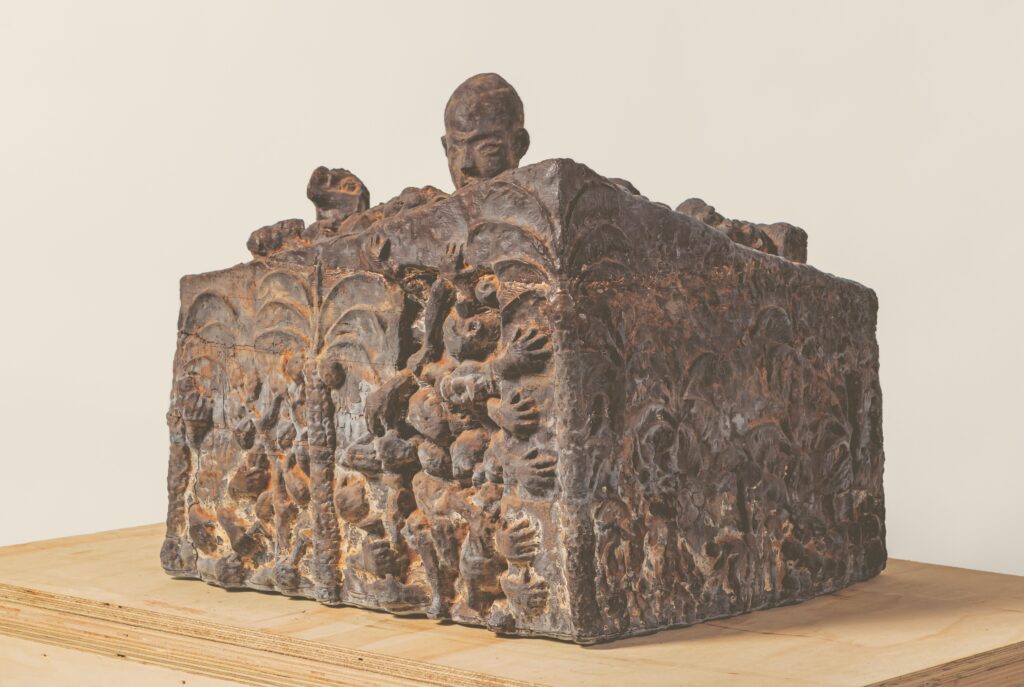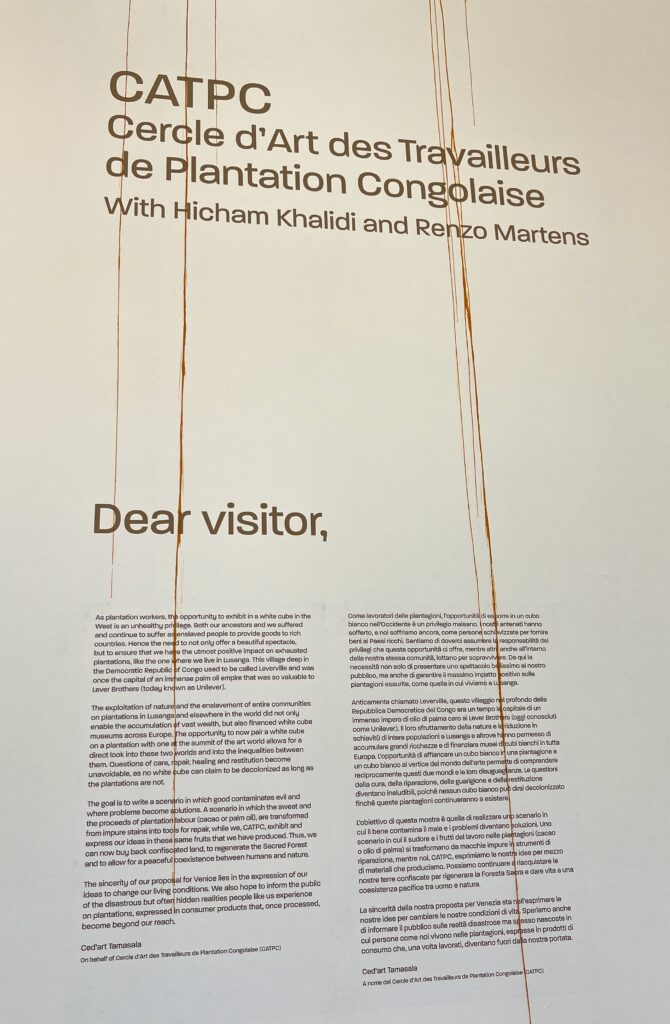While at the Venice Biennale, after installing my work at the Grenada Pavilion, I visited several national pavilions. This is from my visit to the Dutch Pavilion.
A poster with brown rivulets down the text, begins, in oversized letters, Dear Visitor. The more miniscule text draws you closer to read the letter on behalf of the CATPC, the Congolese Plantation Workers’ Collective or Cercle d’Art des Travailleurs de Plantation Congolaise which represents the Netherlands—the Dutch Pavilion—at the International Art Exhibitions of the Venice Biennale. The Biennale’s theme is Foreigners Everywhere. Its first lines:
As plantation workers, the opportunity to exhibit in a white cube in the West is an unhealthy privilege. Both our ancestors and we suffered and continue to suffer as enslaved people to provide goods to rich countries.
The letter speaks to the village of Lusanga, Democratic Republic of Congo, the site of the first plantation belonging to Lever Brothers—which later became Unilever—manufacturers of many brands that are part of our daily lives in Grenada. Lusanga was once the capital of Leverville, British magnate William Lever’s massive palm oil empire.
On entry to the Dutch pavilion, the smell of chocolate/cocoa is heavy. However, the visceral sculptures—created from clay taken from the last patches of untouched forest surrounding the plantation, then cast in cacao and palm fat extracted from the plantation—that shock the system. The presentation called Art or Earth? The International Celebration of Blasphemy and The Sacred, highlights the Lusanga community’s work over the past 10 years, exhibiting and selling the sculptures globally, and using the funds to reclaim over 200 hectares of ancestral land.

Art or Earth? The International Celebration of Blasphemy and The Sacred, Dutch Pavilion. Photo: SLCT
Such is the power of cacao/cocoa/chocolate.
The heavy smell transported me home, and the possibilities of a similar event as part of the annual Grenada Chocolate Festival to connect Grenada’s agricultural and cocoa plantation history. The festival in May, celebrates everything cocoa and chocolate; from the cocoa farmers and chocolate makers to the products of Grenada’s 6 chocolate labels—Belmont Estate, Crayfish Bay Organics, Diamond Chocolate Factory, Taste D Spice, Tri Island Chocolate, and the first, the Grenada Chocolate Company. Formed in 1999 by Americans Mott Green and Doug Browne, and Grenadian Edmond Brown, the Grenada Chocolate Company revolutionised the chocolate industry in Grenada, and pioneered the tree to bar movement leading to the global phenomenon that is Grenada Chocolate. During our preview at the Grenada Pavilion, Commissioner Susan Mains shared Mott’s story and Grenada chocolate with our audience, thanking him for his perseverance and his vision which, in part, lead to Grenada showing at Venice.

White Cube Lusanga, 2020 by CATPC artists Jean Kawata and Ced’art Tamasala). Photo: Peter Tijhuis/Mondriaan Fond
Caribbean cacao/cocoa/chocolate history is linked to slavery, and in Grenada, chocolatier Cadbury—whose items flood the local market—once owned Samaritan Estate in St Patrick, and a Grenada chocolate manufactured in Birmingham, England is on an 1800s list. The Pure Grenada site states, “If Willy Wonka had a chocolate island it would certainly be Grenada.” I have seen the Willy Wonka movies starring Gene Wilder (1971) and Johnny Depp (2005) based on Roald Dahl’s 1964 book Charlie and the Chocolate Factory more than once, and I often thought the whole Oompa-Loompas thing smacked of slavery. In his book, Dahl depicted them as tiny black people that Wonka brought from the deepest, darkest part of Africa, smuggled in large cases, to work in his factory and paid in cacao beans. Regarding the chocolate festival and by extension our cocoa farmers, the Pure Grenada blurb sends an uncomfortable message, appearing to support the old model of locals producing things at low rates for foreigners to enjoy, or to sell back to us at inflated prices.
The varied activities hosted by our chocolate factories and the festival greatly upscale the benefit for Grenada cacao/cocoa/chocolate. Every edition of the festival hosts at least one art and craft exhibition themed on cacao/cocoa/chocolate, linking local artists and artisans to agriculture. The Congolese artists, some of whom were at the Dutch Pavilion, took justice as an endpoint and cacao/cocoa/chocolate as art as a means to that end. Artists in Grenada can do similar; utilise a local commodity to produce earth-grown Grenada art that speaks to our land history and heritage, and perhaps add to the conversation on reparations.



